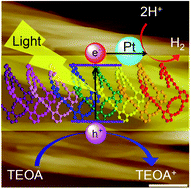A dehydrobenzoannulene-based three dimensional graphdiyne for photocatalytic hydrogen generation using Pt nanoparticles as a co-catalyst and triethanolamine as a sacrificial electron donor†
Abstract
The major advantage of alkyne chemistry, the chemical tailorability of the alkyne triple bond, ensures synthetic control over the electronic and chemical structure of graphdiyne. The three dimensional arrangement of alkyne units provides a very wide space for chemical derivation of graphdiyne, which would promote the development of new kinds of carbon materials with a clear structure, high activity and stability. Herein, we would like to report the synthesis and self-assembly of a crystalline dehydrobenzoannulene-based three dimensional graphdiyne, PDBA, with the above-mentioned perfect characteristics. A typical helical fiber-like structure was formed by polymerization-induced self-assembly, which exhibits good ability for water splitting with a photocatalytic H2 generation rate of 340 μmol h−1 g−1 and an apparent quantum efficiency of 4.68% at 420 nm. This discovery paves a new way for developing functionally oriented carbon materials through controlling the dimensionality and shape of alkynes.



 Please wait while we load your content...
Please wait while we load your content...